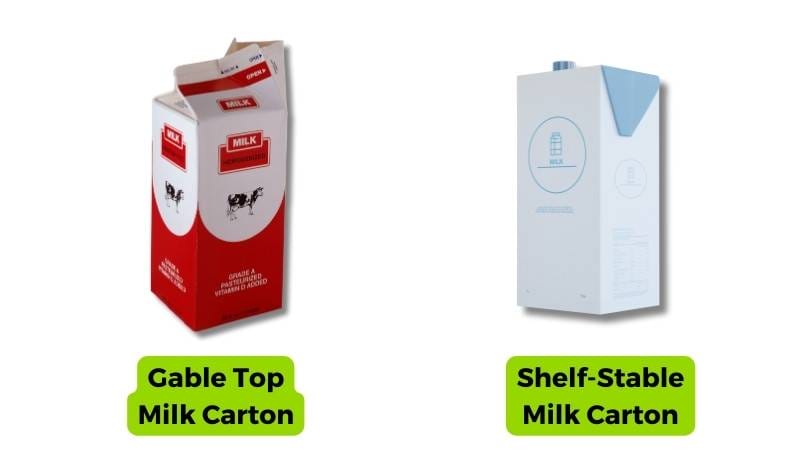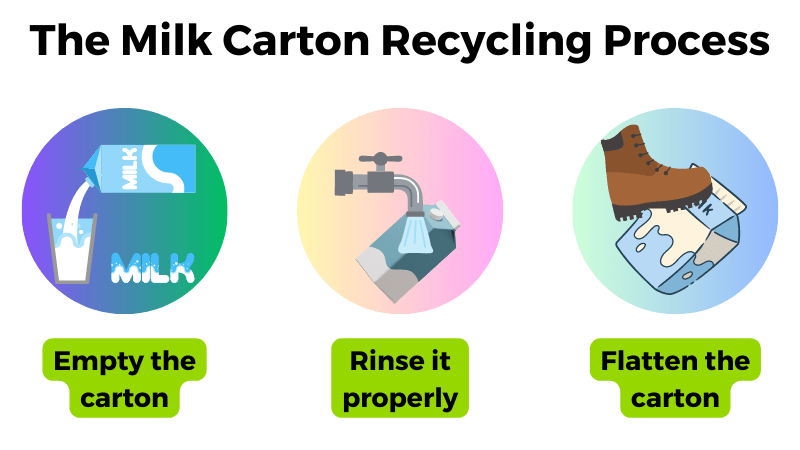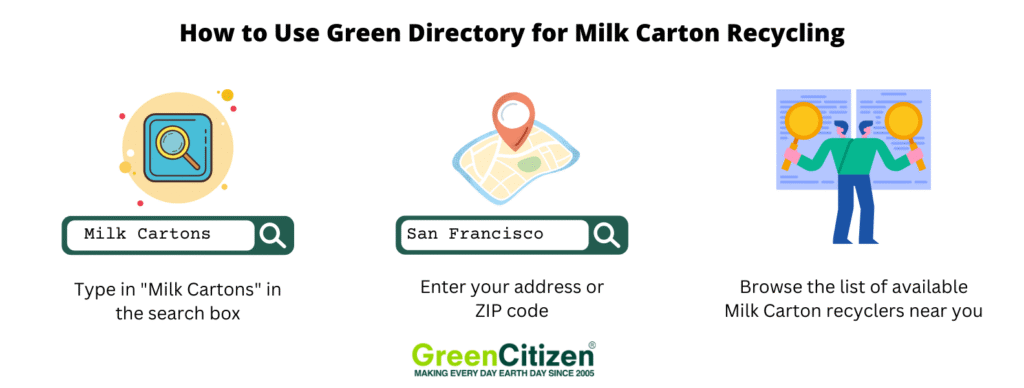Have you ever thought about recycling milk cartons? It’s a common dilemma: trash or recycling bin?
Let me clarify something first, all types of milk cartons are recyclable. Yet, the ability to recycle them depends on your local facilities. Historically, recycling these cartons was challenging due to their mix of plastic, paper, and sometimes aluminum.
The good news? Now, 62% of U.S. communities can recycle milk cartons, a significant improvement thanks to advancements in recycling technology.
Remember, the next time you finish a milk carton, you have the power to make a positive environmental impact.
Can You Recycle Milk Cartons?

Yes, you can recycle milk cartons! Contrary to some misconceptions, the majority of milk cartons are fully recyclable.
These cartons are primarily made of paper, with a thin layer of plastic or sometimes aluminum to keep the liquid inside fresh. That composition means they can be broken down and turned into new paper products.
Now, before you jump up and toss your carton into the recycling bin, there’s a small catch: not every recycling program accepts them. It’s essential to check with your local recycling program to see if they handle milk cartons. A quick call or a visit to their website should give you the answer you need.
So, while milk paper cartons are designed to be recyclable, the key is to ensure your local facilities are equipped to process them.
What Are Milk Cartons Made Of?
Composition of a Typical Milk Carton
When we think of a milk carton, we often imagine it as a simple paper box.
In reality, there’s more to it. The bulk of a milk carton—about 75%—is paperboard. This paperboard gives the carton its structure and strength. But paper alone wouldn’t hold our milk very well, would it?
That’s where the remaining 25% comes in a thin layer of plastic and aluminum.
So basically, a typical carton is made of three materials — paper, plastic, and aluminum.
This lining forms a liquid-tight seal that keeps our milk fresh and prevents it from soaking through the paper. It’s a clever design, but this mix of materials is what makes milk cartons a unique challenge when it comes to recycling.

Read More:
Different Types of Milk Cartons
Believe it or not, not all milk cartons are created equal. We generally find two types of cartons in our fridges:
Gable Top Cartons
These are the traditional milk cartons that you’d find in the refrigerated section of your supermarket. This is why sometimes these are called refrigerated cartons. They are primarily made of paperboard and have a plastic lining. While the paperboard is recyclable, the plastic lining must be separated, which some recycling facilities can do, but others might not.

Aseptic Cartons
Also known as Tetra Paks or shelf stable cartons, these cartons are typically used for shelf-stable or non-refrigerated liquids. Aseptic cartons are composed of paperboard, plastic, and often a layer of aluminum. Their recyclability is a bit trickier due to the aluminum and plastic layers, but there are specific facilities that can handle these materials.
So, while both types of cartons are primarily made of paperboard, their different linings and treatments play a big role in how and where they can be recycled. It’s this variety that makes checking with your local carton recycling program so crucial.

Read More:
The Milk Carton Recycling Process
Preliminary Steps
Before a milk carton can begin its journey to becoming something new, it has to be properly prepared — and that starts in our own kitchens.
First things first, we need to empty the carton completely. Every last drop of milk needs to go. After that, give it a good rinse. We’re aiming to remove any remaining milk, as this can contaminate the recycling process.
Then, it’s time to flatten the carton. This isn’t just to test our strength; flattening cartons saves space in the recycling bin and makes them easier to transport.
It’s simple — empty, rinse, and flatten — three steps that set our cartons on the path to a second life.

Industrial Recycling
Now, let’s follow our carton to the materials recovery facility, where the real magic happens. First, the cartons are sorted and separated from other recyclables.
Then, they’re soaked in water, transforming into a slurry — imagine a milk carton smoothie. This slurry helps to separate the paper fibers from the plastic and, if present, aluminum linings.
Once that separation is complete, the paper fibers are moved on to be cleaned and bleached, turning them into a bright pulp. This pulp, which started as our everyday milk carton, is now ready to be crafted into new paper products, like paper towels, tissues, or even writing paper.
The remaining plastic and aluminum aren’t destined for the landfill, though. They can be processed further, sometimes being used to create energy or turned into building materials.
So, from our kitchens to the materials recovery facility, milk cartons go through a remarkable transformation.
Challenges in Recycling Milk Cartons
Contamination Concerns
One of the biggest hurdles in carton recycling is contamination.
Picture this: a milk carton that still has some leftover milk or dairy products inside. That remaining liquid can spoil, and when it does, it can contaminate a whole batch of recyclables.
This is why it’s so crucial to thoroughly rinse our food and beverage cartons before tossing them into the recycling bin.
In some cases, if the contamination is severe, the whole batch may have to be discarded, which is a scenario we all want to avoid.
It’s a simple action, but ensuring our cartons are clean is a significant step in effective carton recycling.
Limited Facilities: Not All Of Them Recycle Cartons

Here’s where things can get a bit tricky: not all recycling facilities are equipped to recycle cartons. Because of the specific process required to separate the paper from the plastic lining in milk cartons, some facilities might not accept them at all.
This is why, despite being designed for recycling, our cartons sometimes have nowhere to go.
It’s not a hopeless situation, though.
To tackle this challenge head-on, I strongly recommend taking a moment to use the Green Directory from GreenCitizen. It’s a fantastic tool that can help you find nearby recycling centers that specifically accept milk and other food and beverage cartons.
By using resources like this, we can ensure that our efforts to recycle cartons are fruitful and that we’re contributing positively to the sustainability movement.
So, as you can see, while recycling cartons comes with its set of challenges, with a little extra effort and knowledge, we can all play a part in making sure our milk cartons get a second life.
How to Properly Recycle Your Milk Cartons
Steps to Prepare Milk Cartons
Before we send our milk or ice cream cartons off for a new life, we need to prep them. Just like we wouldn’t send a friend out into the cold without a coat, we wouldn’t send our cartons to a recycling facility without a proper clean-up. Here’s a quick step-by-step guide to get your paper cartons ready for recycling:
- Empty the Carton: Make sure all the liquid or food residue is completely removed from the carton.
- Rinse Thoroughly: Give your cartons a good rinse. This includes milk cartons, ice cream containers, and juice cartons alike. A quick rinse removes any leftover residues.
- Flatten the Carton: Flatten your cartons to save space. This goes for both shelf stable and refrigerated cartons.
- Store Properly: Until you’re ready to recycle, keep your cartons in a dry place.
- Check for Caps and Spouts: Remove any plastic caps or spouts from the cartons before recycling.
Finding a Local Recycling Facility
Now that our cartons are clean and flat, where should they go? Unlike glass containers, which are widely accepted, carton recycling requires a bit more detective work. But don’t worry, I’ve got some tips for finding the right place:
Call Your Local Recycling Center
Give your local recycling facility a call. A quick conversation can confirm whether they accept paper cartons, including milk, ice cream, and juice cartons.
Municipal Website or Hotline
Check your city or county’s recycling webpage or give their hotline a call. They can provide information on carton recycling in your area.
Drop-off Locations
Some areas have specific drop-off locations for recycling cartons. These might be different from where you recycle plastic containers, so it’s worth checking.
Use the Green Directory
Once more, our friend Green Directory from GreenCitizen comes to the rescue. It’s an excellent resource for locating recycling centers that accept both shelf stable and refrigerated cartons.

Frequently Asked Questions (FAQ)
Milk cartons are primarily made of paperboard, but they often have a thin layer of plastic or aluminum. Generally, they go with paper recycling, but it’s best to check with your local recycler.
Plastic milk jugs, usually made from HDPE plastic, are widely accepted in most recycling programs. Check the bottom of the jug for the recycling symbol with a “2” inside; this indicates it can be recycled.
Yes, plastic milk jugs, typically made of HDPE (High-Density Polyethylene), are one of the most commonly recycled plastics. They can be turned into new jugs, plastic lumber, furniture, and more.
Yes, crushing milk cartons before recycling is a good practice. It saves space in your recycling bin and makes the cartons easier to transport to recycling facilities.
Conclusion
Recycling isn’t just a chore—it’s a call to action, a daily habit that puts us on the path to a cleaner, greener planet.
When we toss our milk cartons into the recycling bin instead of the trash, we’re not just disposing of waste; we’re contributing to a solution. We are taking a stand for our planet, minimizing our contributions to landfill masses and lowering our greenhouse gas emissions.
It’s a simple act, but imagine the ripple effect if we all played our part consistently.
So, the next time you finish a carton of milk, think about where it’s headed. With just a little effort, we can ensure it’s off to a new life, rather than becoming one more burden on our planet. Let’s take that step, making our world a cleaner, healthier place — one milk carton at a time.

